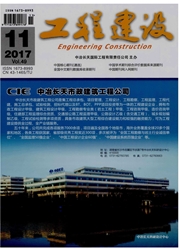

 中文摘要:
中文摘要:
以某钢桥的"斜腿刚构部"为例,利用有限元软件TDAPⅢ建立模型,输入横桥向地震波进行时程分析。验算发现,主要受力构件存在屈曲现象。将斜腿的部分斜杆替换为防屈曲支撑并重新分析计算,数值结果表明:加固后结构的安全性显著提高,稳定性符合规范要求;该加固方案会减小大桥的横桥向抗侧刚度,但并未增大横桥向地震位移,斜腿和主桁代表性单元的节点在横桥向的最大地震位移分别减小了15.72%和19.15%;防屈曲支撑在地震过程中可产生较大的轴力和变形,但均未超过容许值,其滞回曲线稳定且饱满。因此,将大桥斜腿的部分斜杆替换为防屈曲支撑的加固方案安全可靠,能达到加固目的且不增大结构的地震位移。
 英文摘要:
英文摘要:
With the"slant-legged rigid frame part"of a steel bridge as an example,the finite element software TDAPIII was used to establish model,and the transverse earthquake wave was input to make the time-history analysis. The check calculation result indicates that the main bearing members will buckle under the earthquake. Replacing parts of the slant rods with BRBs and recalculating,the numerical result indicates that,the structural safety improves significantly after reinforcement,and the stability conforms to the code requirements; The reinforcement scheme will reduce the transverse lateral stiffness,but will not increase the transverse seismic displacement,the transverse maximum seismic displacement of representative units like slant legs and main trusses is reduced by 15. 72% and 19. 15% respectively; large axial force and deformation will appear in BRBs during the process of earthquake but the values are always under the allowable values,BRB's hysteretic curves are stable and full. Therefore,the reinforcement scheme of replacing parts of the inclined rods with BRBs is safe and reliable,and it can achieve the purpose of reinforcement and will not increase the seismic displacement of structure significantly.
 同期刊论文项目
同期刊论文项目
 同项目期刊论文
同项目期刊论文
 期刊信息
期刊信息
